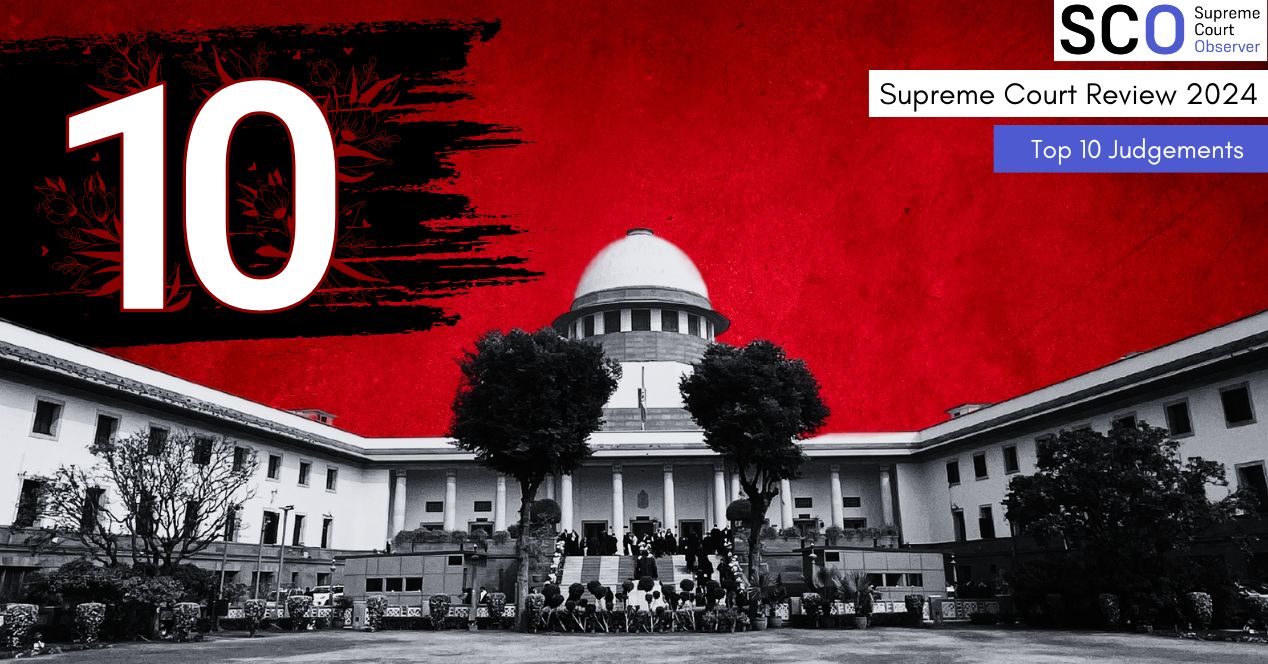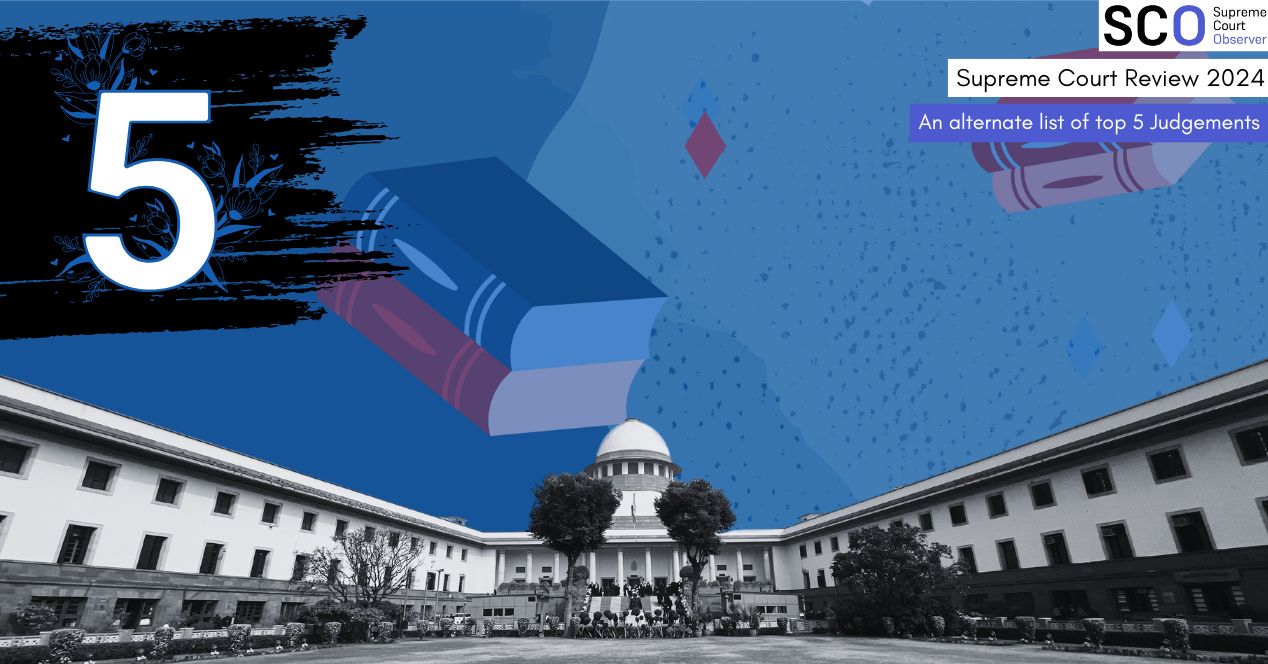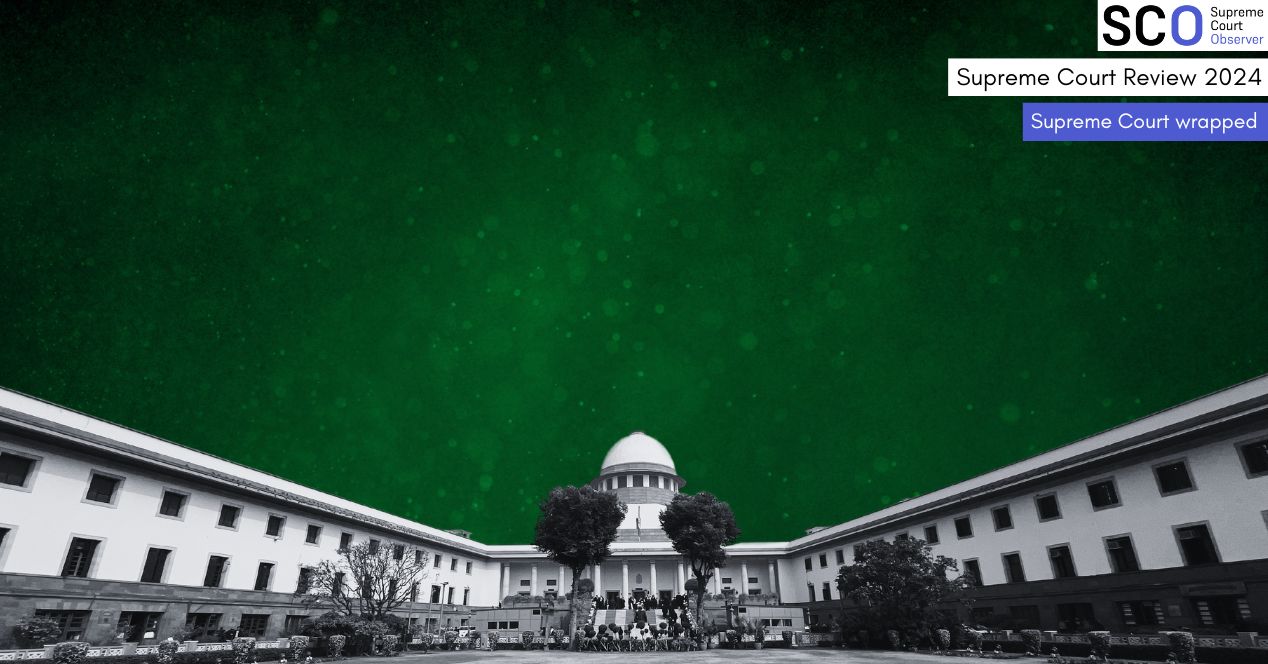Channel
Top 10 judgements of 2024
Among the many landmark decisions of 2024, we pick the ones that could potentially impact large constituencies of the population
Transcript:
Gauri: Hello everyone! As 2024 comes to a close, we follow SCO’s grand tradition of reviewing the year that went by! The flagship article of our year ender series is the our list of the top 10 judgements of 2024. Picking 10 landmark judgements was no easy task. Especially because, almost a 1000 judgements were delivered this year.
Advay: So our guiding light while putting together this list was ‘impact’: we filtered the set of judgements through the lens of the effect they could potentially have on large and critical constituencies such as taxpayers, homeowners, voters and minorities. Here goes Supreme Court Observer’s annual list of the Supreme Court’s top 10 Judgements.
1) Withdrawal of remission granted to Bilkis Bano convicts | Bilkis Yakub Rasool v Union of India | Two-judge bench
Gauri: A judgement that quashed the Gujarat government’s order to release 11 convicts in the Bilkis Bano case was the first big decision to make headlines from the Supreme Court in 2024. The convicts were sentenced for life for the gang rape and murder of Bano’s family during the 2002 Gujarat Riots. Notably, the convicts were sentenced in Mumbai, making the Maharashtra government the appropriate authority to consider remission.
The judgement suggests that the Gujarat government was aware of the convicts’ mischief of applying to the wrong government and still considered their application. The judgement put on record that the Gujarat government acted “in tandem” with the convicts. Further, it held that although the decision to release convicts rests in the administrative domain, courts have the authority to quash remission orders.
2) Validity of the Electoral Bonds Scheme | Association of Democratic Reforms v Union of India | Five-judge bench
Advay: In the lead-up to the 2024 Lok Sabha Elections, a five-judge bench quashed the 2018 Electoral Bond Scheme. The Scheme allowed corporations, individuals and organisations to donate anonymously to political parties. On 15 February, the Court unanimously held that voters had a right to be informed about the sources of party funding. The Court ordered the immediate halt of bond sales and asked the Election Commission and the State Bank of India to publicly disclose the data they had hitherto collected on EB transactions.
3) Bail for Delhi Chief Minister Arvind Kejriwal | Arvind Kejriwal v Directorate of Enforcement | Two-judge bench
Gauri: The Arvind Kejriwal bail saga had the effect of relaxing the stringent interpretation of the bail norms in the Prevention of Money Laundering Act (PMLA), 2002. Kejriwal was arrested by the Enforcement Directorate (ED) for his alleged role in the Delhi Liquor Policy scam. He was also arrested by the Central Bureau of Investigation (CBI) on corruption charges in connection with the same scam. The Court noted that Kejriwal had suffered long periods of incarceration and that the trial in his case was unlikely to commence in the foreseeable future.
The Court’s decision seemed to open the doors for the release of other incarcerated Opposition political leaders like Manish Sisodia, K. Kavitha and V. Senthil Balaji. Many of the subsequent orders, too, referred to the delay in commencement of trial. More than once, the Court reiterated the maxim of “bail is the rule, jail is the exception” in the context of PMLA cases.
4) Validity of sub-classification within reserved categories | State of Punjab v Davinder Singh | Seven-judge bench
Advay: In a potentially far-reaching judgement on the affirmative action jurisprudence in the country, a seven-judge bench of the Supreme Court upheld states’ power to create sub-classification within the reserved Scheduled Caste and Scheduled Tribe categories (SC/ST).
The majority reasoned that sub-classification was permissible to ensure “substantive equality” since different communities in the SC/ST list faced varying degrees of discrimination and inequality. The bench, however, held that any law creating sub-classification had to be based on empirical evidence and would be subject to judicial review.
In the wake of the judgement, several state governments indicated that they were keen to advance sub-classification. Haryana was the first to do so—weeks after the judgement, the Nayab Singh Saini-led BJP government approved the Haryana Scheduled Caste Commission Report, which recommended a 10 percent ‘sub-quota’ for deprived SCs in government jobs. Earlier this month, Telangana chief minister Revanth Reddy announced that the Commission constituted by his government to study sub-classification would submit its report. Reddy’s Congress government has made it clear that there would be a positive outcome for the Madiga community, which was prominent in spearheading the movement in favour of sub-classification.
5) Taxation of mines and minerals and regulation of industrial alcohol | Mineral Area Development Authority v Steel Authority of India; State of UP v Lalta Prasad Vaish | Nine-judge bench
Gauri: Two nine-judge benches dealt with the distribution of law-making powers between the Union and state governments this year. In Mineral Area Development Authority, an 8:1 majority held that Parliament’s power to make laws on mines and minerals cannot be extended so far that it usurps states’ powers to legislate on the subject. In Lalta Prasad Vaish, in a similar majority, the Court found that the Union’s powers under List I of the Seventh Schedule cannot be used to take away the powers that List II has vested in the states. Thus, state governments had the power to regulate industrial alcohol.
In these cases, the majority found that a clear division of legislative powers between the states and the centre was critical for maintaining India’s federal structure. Interestingly, Justice Nagarathna dissented and expressed similar concerns observing that the Union’s control on subjects like minerals and industrial alcohol allowed it to take decisions that would prevent uneven economic development and discourage inter-state rivalries.
6) Possessing child pornography punishable under POCSO Act | Just Rights for Children Alliance v S. Harish | Two-judge bench
Advay: As a result of the Supreme Court’s judgement in Just Rights for Children Alliance v S Harish, India is now part of a club of jurisdictions which have explicitly criminalised the viewing, storing and possession of ‘child pornography’. The Court objected to the use of the phrase in formal contexts and noted that it should be called ‘child sexual abuse and exploitative material’ or ‘CSEAM’. For years, High Courts had been struggling to coherently answer whether ‘mere possession’ of explicit videos involving children came under the purview of the Protection of Children from Sexual Offences Act.
It also found that the ‘safe harbour’ clause under Section 79 of Information Technology Act, 2000, which immunises intermediaries from liability for third-party information, does not apply to ‘child pornography.’ Now, if intermediaries don’t take down such material], their safe harbour protection will lapse.
7) Validity of Section 6A of the Citizenship Act (Assam Accord) | In re: Section 6A of Citizenship Act | Five-judge bench
Gauri: The judgement upheld Section 6A Section 6A of the Citizenship Act, 1955 . It grants citizenship to migrants who entered Assam before 24 March 1971. Rejecting claims that the provision dilutes Assamese culture and amounts to external aggression, the majority acknowledged Assam’s distinct identity and emphasised that Assam’s cultural concerns arose from non-implementation of the provision rather than the provision itself.
In Assam, where the interplay of migration, ethnicity and language is particularly sensitive, Section 6A remains both a product of compromise and a flashpoint for debates about identity and inclusion.
8) Private property as a material resource | Property Owners Association v State of Maharashtra | Nine-judge bench
Advay: In a Constitution Bench matter that was one of the longest-pending in the Court, the nine-judge bench had to grapple with two significant questions:
- Whether Article 31C continued to exist in the Constitution after the decision in Minerva Mills v Union of India (1980)
- Whether privately owned property was a “material resource of the community” under Article 39(b) of the Constitution.
On 5 November 2024, a nine-judge bench unanimously held that Article 31C continued to exist in the Constitution. This provision protects laws that advance Directive Principles enshrined under Article 39(b) and (c) against fundamental rights challenges. In an 8:1 majority, the judges also held that not all privately owned property was a “material resource of the community” under Article 39(b). Private property could be a material resource if it fulfilled certain criteria like availability, nationalisation, acquisition etc.
9) Minority status of AMU | Aligarh Muslim University v Naresh Agarwal | Seven-judge bench
Gauri: The Supreme Court overruled a 57-year-old precedent set by a five-judge bench in Azeez Basha v Union of India (1967). Azeez Basha had held that Aligarh Muslim University (AMU) does not have a minority status under Article 30 as it was established through a Union legislation (the AMU Act of 1920). In November, in a 4:3 majority, the Court held that institutions incorporated by a legal instrument can have a minority status if the founder was a person from the minority community. It also put down specific parameters to determine the minority status of any religious or linguistic educational institution established under Article 30.
This was also the first time when the Supreme Court, in 75 years, laid down such indicators. The parameters will assist a smaller bench in determining whether AMU is a minority institution or not. It will also be useful in determining the minority status of other institutions too.
10) Guidelines to curb illegal bulldozer demolitions | In Re: Directions in the matter of demolition of structures | Two-judge bench
Advay: In September 2024, the Court issued detailed directions to curb bulldozer demolitions nationwide. The Court ruled that bulldozer demolitions of this nature infringed fundamental rights, such as the right to shelter, diluted the separation of powers by making the executive judge and jury and undermined the rule of law. The bench also laid down some procedural guidelines: a written notice to be served to the owner-occupier at least fifteen days ahead, keeping collectors and district magistrates in the loop about notices and ensuring personal hearings before a designated authority. It also held that the ground-level government officers would pay from their own pockets if any procedure is violated.
Gauri: With that, we conclude our round up of the top 10 judgements of 2024! Let us know the cases that you think were the biggest this year in the comments below. And do tell us if you can think of a case that should have been on our list!
Advay: And don’t forget to read the article of the top 10 decisions on the website where we discuss the cases in greater details. We’ve also got other stories rounding up the Supreme Court’s activity in 2024.
Gauri: As we wrap up this video, we want to take an opportunity to thank all of you, our wonderful viewers and readers who support our work everyday. Keep following SCObserver.in for Court side reporting on key cases that matter to me and you! Thank you for watching and have a Happy New Year! We will see you soon!




